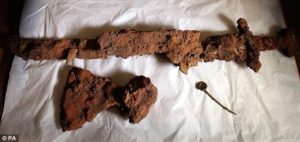On the 8th May the Centre had the pleasure of welcoming our very own Dr Stephen Harrison to discuss his latest research ‘In Pursuit of the Scotto-Norse: Reconsidering the Viking Graves of Scotland’. Stephen used this opportunity to ‘stick his neck out’ and play with some thoughts and theories that he has developed following on from his PhD research on Viking Ireland. The first thing on Stephen’s agenda was to explain his title. Within the academic discussions on Viking settlement elsewhere in Britain it is largely accepted that hybrid cultures and identities emerged out of the assimilation of native and Norse cultures. The emergence of a ‘Hiberno-Norse’ identity in Ireland is a prime example of this. However, in Scotland there has been little to no discussion of any ‘Scotto-Norse’ identity. Stephen wanted to use this opportunity to examine Viking burials in Scotland to see if there was any justification for such a phenomenon.
The weapon finds from the Ardnamurchan boat burial (BBC News)
Viking burials – that is, furnished Norse burials with grave goods – have been at the core of Viking studies for over a century. They are seen as intrinsically Scandinavian and conservative, the sign of Viking culture no matter where they are found. These graves have largely been divided into two categories: male burials and female burials. Male burials are typically defined by the presence of weapons, whilst female graves usually contain rounded brooches. Stephen’s PhD thesis identified a third grouping, bubbed ‘tertiary burials’, which contained neither of these markers. By producing a systematic review of antiquarian and modern reports of Viking burials in Scotland, Stephen found that there are 84 sites across the country, with 140 graves in total. What is particularly interesting is that 60% of these graves are female. This is in stark contrast with findings elsewhere, particularly Norway, where Bergljot Solberg identified only 15% of burials as female. To make matters even more exciting, through strontium isotope analysis it has been found that the majority of those buried within the Scottish female graves were neither Scandinavian or local. A true anomaly which asks some fundamental questions as to what is going on here.
Oval brooch found at Ballinaby, Islay (The Viking Compendium).
Another interesting difference is the prevalence of the reuse of sites for Viking graves. This is not uniquely Scottish, as the majority of graves within Britain and Ireland are on pre-existing Christian or prehistoric sites. However, in Scotland the majority of these can be found on prehistoric sites rather than Christian sites. This is the reverse of the pattern in England. Stephen argued that this was a deliberate attempt to associate the dead with the land. Again, this is completely different from the situation back in Scandinavia, where it is much rarer to find burials on prehistoric sites.
Female burial from Orkney (Viking Burials Blog).
When bringing the talk to a close, Stephen pondered what all this could mean. Certainly the prevalence of female graves is unique, suggesting that these women had equal or even higher status than their male counterparts. The prevalence of reuse of prehistoric sites suggests that this was a settled population, but the lack of any hybrid goods (like those found in Dublin) shows that there was no exceptional local influence. Whilst all of this does not scream out for the existence of a unique Scotto-Norse identity, there is certainly something very unique occurring here. On that tantalising note, Stephen called for more research to unearth what exactly is going on in Scotland during this crucial period of time.
The next Centre event is the final instalment of the Historical Conversations series on Archiving Scotland, with Irene O’Brien, George MacKenzie, Lesley Richmond, and John Scally. Join us at the Kelvinhall on 15th May at 5.30pm. Please book tickets through our Eventbrite page: https://www.eventbrite.com/e/historical-conversations-tickets-36636178797.





Very interesting! I am but a novice in any of these subjects, but I have a infinite admiration of this type of education! Thank you!
There is a plethora of archaeological evidence for the ‘Viking’ presence in Scotland and the Isles – most of them appear to have settled and quickly assimilated with the local populations (or became the local population where there previously was none) – it’s a fascinating topic. There is however, already a term used for those in Scotland of Norse origin – Norse-Gaels.
There is no logic in creating a neologism – ‘Scotto-Norse’ to describe an already existing group. It is Norse-Gael.
Scotto, a geografic term = Gael(Britons), as a ethnic term for generic Celts.
Viking term in this case cover the Angli from Jutland or the Gothi from Scandinavia ?
Or both?